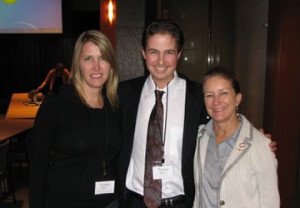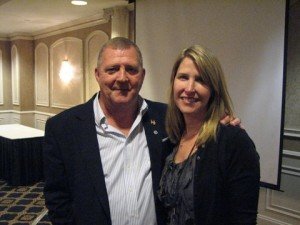People.com profiles Trevor Schaefer and his fight to identify disease clusters throughout the United States. Click to read the article and watch the video.
As the mother of a child in a confirmed cancer cluster in Alabama, I know firsthand how frustrating it can be to deal with polluters, politics and public health agencies. Public health agencies at the state and federal levels are ill equipped to respond to suspected disease cluster communities. This leaves parents of children in communities where rare cancer is commonplace bearing the burden of activism. Throughout my nearly decade-long journey with childhood cancer, I have felt like a lone voice crying in the wilderness, concerned about rare cancer rates in my community, without anywhere to turn for solid answers.
Cancer Clusters: What are we afraid of?
NCI Notable Cancer Statistics for Baldwin County
From 2010 through 2014, National Cancer Institute Statistics also showed these notable cancer statistics for Baldwin County:
Baldwin County is ranked second of 67 counties in Alabama for the highest incidence of childhood cancer under age 15 (Incidence rates per 100,000: Baldwin 17.5; Alabama: 15; US: 16.1). View the full report here or using the State Cancer Profile link on the right.
Here are some other notable stats on Baldwin County cancer.
BALDWIN RANKS:
No. 5 in Alabama for childhood cancer under age 20 for all races and genders (Incidence rates per 100,000: Baldwin 20.4; Alabama: 15.9; US: 17.6).
No. 1 in Alabama for childhood cancer under age 20 for white males (Baldwin County is 88 percent white)(Incidence rates per 100,000: Baldwin 25.6; Alabama: 18.1; US: 19.5).
No. 1 in Alabama for childhood cancer under age 20 for white females (Incidence rates per 100,000: Baldwin 18.8; Alabama: 17.7; US: 18.1).
No. 1 in Alabama for brain cancer for whites under age 50, both genders (Incidence rates per 100,000: Baldwin 4.8; Alabama: 3.9; US: 4.2).
No. 2 in Alabama for brain cancer under age 50, all races and genders (Incidence rates per 100,000: Baldwin 4.3; Alabama: 3.4; US: 3.6).
Trevor Schaefer: Trevor’s Law

Trevor Schaefer with Lesley Pacey and Debbie Quinn at the National Conference on Disease Clusters in Washington, D.C. in September 2012.
Idaho brain cancer survivor Trevor Schaefer has become a champion for kids living in communities where childhood cancer is commonplace.
He helped author S. 76, Strengthening Protections for Children and Communities From Disease Clusters Act, which was introduced in January 2011 by Sen. Barbara Boxer, D-California and supported by Erin Brockovich. The legislation was named Trevor’s Law in honor of this young survivor. Schaefer was one of five people diagnosed in 2002 with brain cancer in his small town. He has devoted his life to advocating for children in disease cluster communities.
If passed by Congress, Trevor’s Law would vastly improve the government’s ability to track and respond to disease clusters. The law would appoint the Environmental Protection Agency as the central agency for disease cluster tracking and response; provide support to state and local health departments for disease cluster investigations; create response teams with expertise from a variety of fields, including community outreach; advance research to improve methods, guidelines, and tools used in disease cluster response; and increase community involvement in disease cluster response. The bipartisan-sponsored legislation remains stalled in the Senate.
“In small towns throughout our nation possible cancer clusters exist,” Schaefer said in his testimony before the U.S. Senate, EPW Committee Oversight Committee on Cancer Clusters and Children’s Health on March 29, 2011. “Parents are trying to get authorities to investigate these clusters and to discern what caused the disease patterns. Scientist and health activists say the government’s current response to disease clusters ranges from piecemeal to non-existent. Some people are told that their small populations render them statistically insignificant. There is nothing insignificant about even one child becoming part of a cancer cluster then dying of that cancer without ever knowing why. Trevor’s Law seeks to rectify that by allowing people in small communities to have their voices heard and their concerns validated about the environmental impact on their children’s health.”
Watch Trevor’s Senate Testimony

Lesley Pacey with Jerry Ensminger in Washington D.C. at the National Conference on Disease Clusters in September 2012. Jerry and Lesley were invited to be guest speakers at the conference that included a screening of Ensminger’s documentary about his tireless efforts to fight for the Camp LeJeune residents who were poisoned by toxic wells at the military base.
Semper Fi, Always Faithful, The Few, The Proud, The Forgotten
Marine Corps Master Sgt. Jerry Ensminger was a devoted Marine for nearly twenty-five years. As a drill instructor he lived and breathed the “Corps” and was responsible for indoctrinating thousands of new recruits with its motto Semper Fidelis or “Always Faithful.” When Jerry’s nine-year old daughter Janey died of a rare type of leukemia, his world collapsed. As a grief-stricken father, he struggled for years to make sense of what happened. His search for answers led to the shocking discovery of a Marine Corps cover-up of one of the largest water contamination incidents in U.S. history.
Semper Fi: Always Faithful follows Jerry’s mission to expose the Marine Corps and force them to live up to their motto to the thousands of soldiers and their families exposed to toxic chemicals. His fight reveals a grave injustice at North Carolina’s Camp Lejeune and a looming environmental crisis at military sites across the country.

President Barack Obama signs the “Honoring America’s Veterans and Caring for Camp Lejeune Families Act of 2012,” in the Oval Office, Aug. 6, 2012. The President is joined by Representative Jeff Miller, R-FL, Representative Brad Miller, D-NC, Jerry Ensminger, Former Master Sergeant, USMC, Mike Partain, Community Representative for the Agency of Toxic Substances and Disease Registry, Rachel Libert, Co–director of Semper Fi: Always Faithful and Tony Hardmon, Co-director of Semper Fi: Always Faithful. (Official White House Photo by Sonya N. Hebert)
Semper Fi Always Faithful, The Few, The Proud, The Forgotten
Watch a Preview of Semper Fi Always Faithful
The Truth 365
The Documentary and Social Media Campaign that Gives a Voice to Kids Fighting Cancer. The goal of The Truth 365 is to educate and mobilize millions of people through Facebook, YouTube, Twitter and other social networking sites. The film informs the public that there is a critical need for funding for pediatric cancer research and that they, the NCI and our elected leaders are in a position to help.
National Disease Cluster Alliance
Each year across the U.S., over 1,000 citizens ask public health agencies to investigate suspected disease clusters, but state agencies are rarely able to offer a substantive response to such requests. Time and again, public health agencies in America fail to properly track and respond to cancer cluster concerns, failing our families – often with life and death consequences. The National Disease Cluster Alliance was formed by parents frustrated by public health agencies response to their suspected disease clusters. The NDCA grew out of the urgent need to identify and respond to emerging disease clusters. It includes scientists, public health professionals, and community activists joined together to help communities facing disease clusters. Through that network, Lesley Pacey found and later convinced two University of Arizona researchers to come to Fairhope.
“Currently, there are no government agencies that either track or respond sufficiently to disease clusters in communities,” states the NDCA website.
